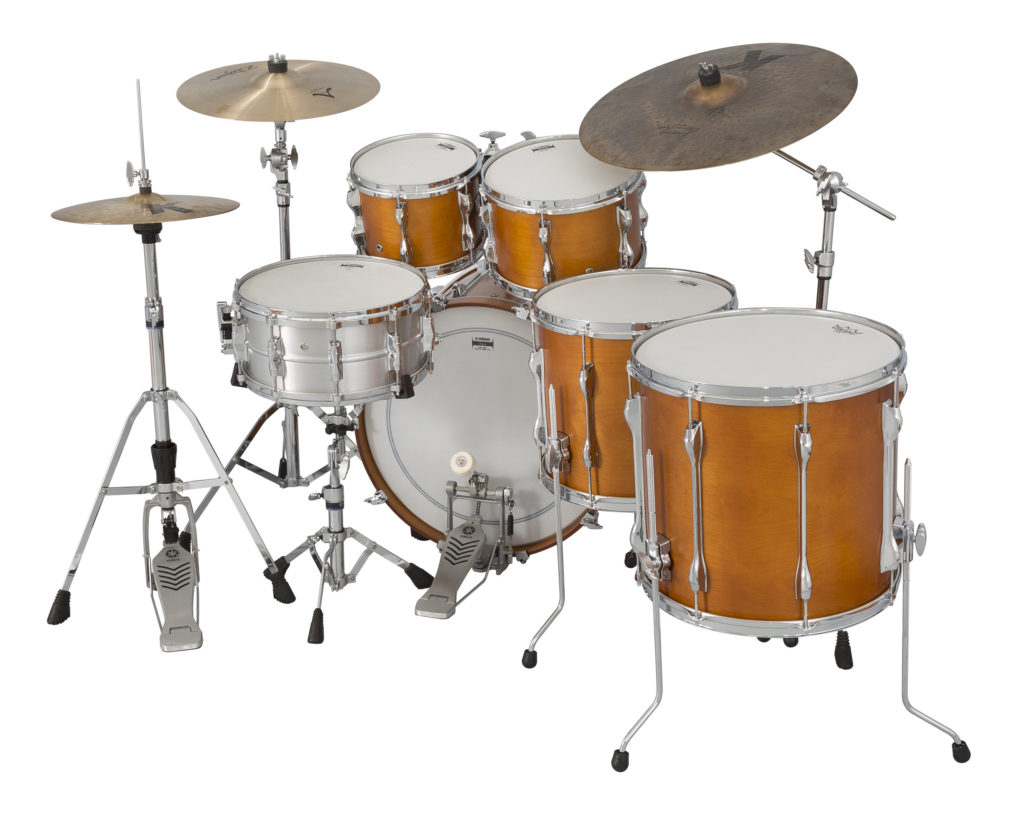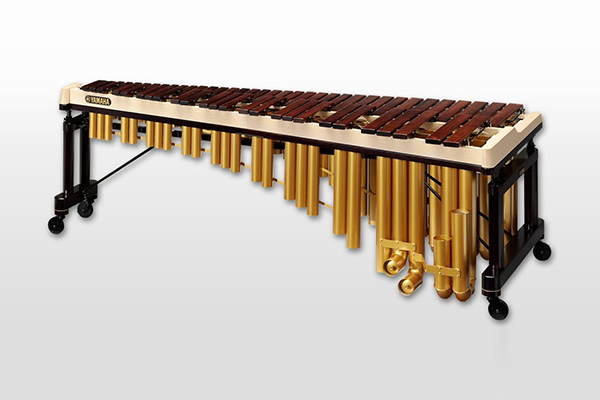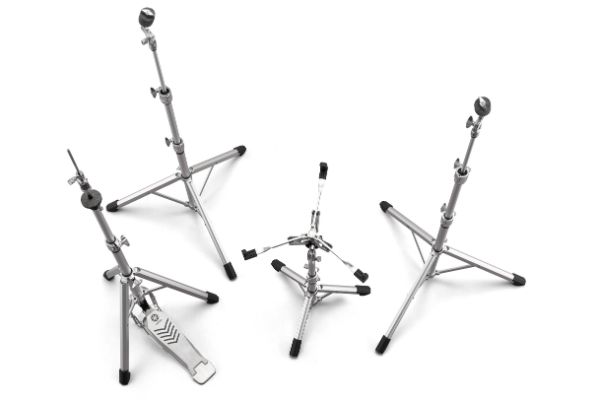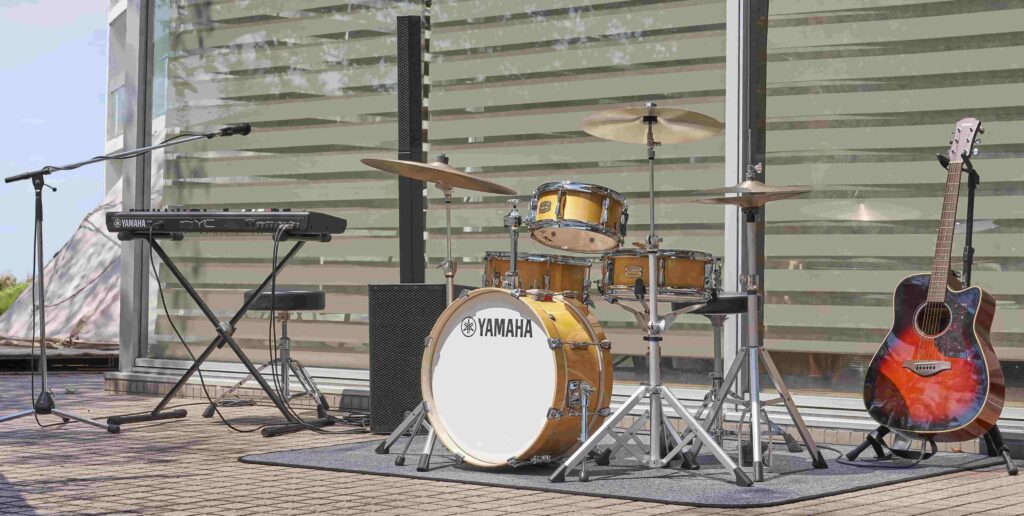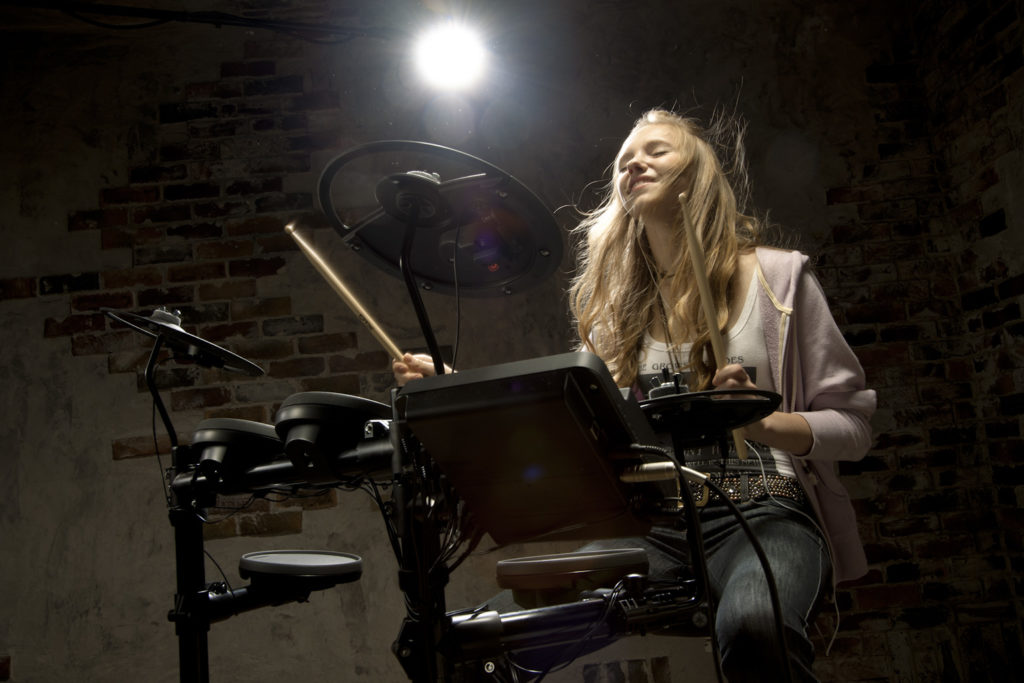A Brief History of Yamaha Timpani
Celebrating over 30 years of timpani.
For more than three decades, Yamaha timpani have been widely used by ensembles of all shapes and sizes in venues from concert halls to football fields.
While various options have changed over time, a number of player-oriented features introduced by Yamaha have remained constant, making these instruments not only accurate and easy to tune but also exceptionally portable and durable. These features include suspended parabolic bowls and extended collars, as well as the usage of Teflon taping to the edges of the kettles so that the heads move quietly over the bearing edges. Yamaha timpani also utilize a unique balanced spring design so the set pitch is maintained even if the player removes his or her foot from the pedal, making pitch changes across the entire range smooth and easy. In addition, all the mechanisms (plus the spider) are located under the base for added protection, with the spring tension adjustment screw placed under the pedal to eliminate unintentional adjustments.
But our timpani have evolved as well. Here are some of the innovations added over the years as different lines have been introduced:
1985
600 Series. Though there were only four sizes (23″, 26″, 29″, 32″), these timpani featured full suspended, deep-drawn copper parabolic bowls, polished on the inside for maximum projection, excellent tonal characteristics and wide tuning range.
1987
6000 Series. This series added a 20″ option to the sizes offered by the 600 Series.
1990
4000 Series. This series consisted of four sizes (23″, 26″, 29″, 32″), with Fiberglass Reinforced Plastic (FRP) bowls. Many of the same features from the 600 Series, such as the removable third wheel and spider mechanism concealed under the base, were also included.
1995
6100 Symphonic Series. These copper timpani were nearly identical to 6000 and 600 Series models. Upgrades were made to the removable third wheel, and a matte black tuning gauge with a red arrow indicator was included.
4100 Concert Series. Nearly identical to the 4000 Series models, these fiberglass timpani provided a good alternative when portability and budget were of concern. As with the 6100 Series, upgrades were made to the removable third wheel, and a matte black tuning gauge with a red arrow indicator was included.
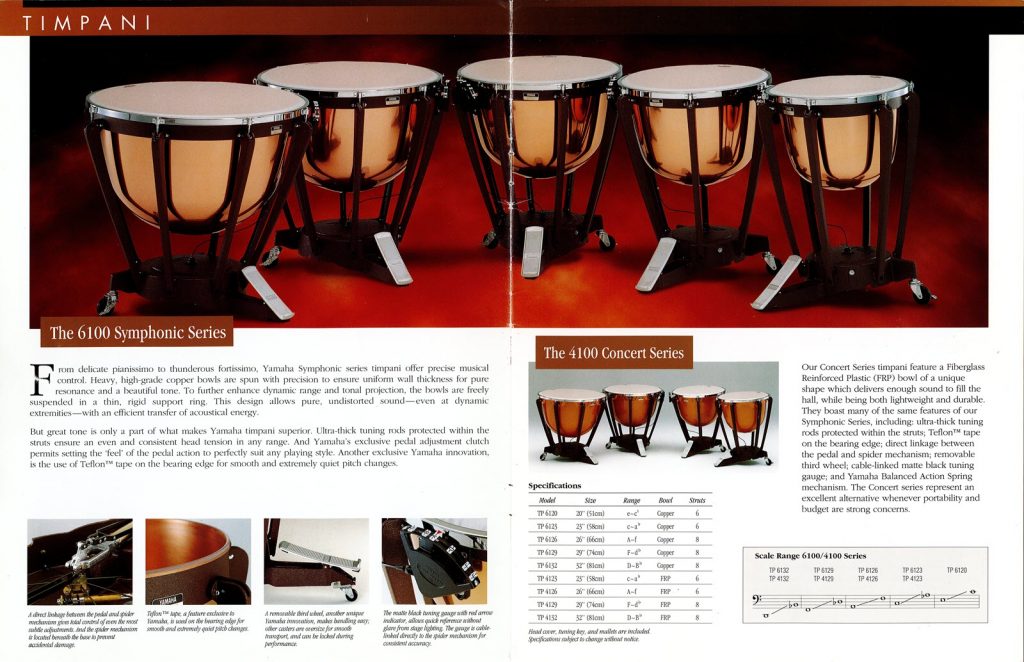
1998
7100 Professional Series. These timpani included all the features in the 6100 Series, but with hand-hammered copper bowls and chrome hoops.
2001
3000 Series. The first portable timpani offered by Yamaha, these featured fiberglass bowls, retractable legs and a fold-up pedal.
2002
During 2002, the entire lineup was redesigned, with the addition of a matte black base, a black pedal and a black hoop for a refined and consistent look across all Yamaha timpani.
6200 Series. New features added to these copper timpani included accidental tuning indicators to offer better tuning accuracy; a redesigned Pedal Adjustment Clutch (PAC); and a reinforced third wheel attachment.
7200 Series. Identical to the 6200 Series except these timpani featured hand-hammered bowls and had options for 24″ and 27″ sizes.
4200 Series. These timpani included all the features of the 6200 series but had Fiberglass Reinforced Plastic (FRP) bowls that were not freely suspended. Only four sizes were available (23″, 26″, 29″, 32″).
2007
3100 Series. These were the first portable Yamaha timpani to not use FRP bowls. Instead, they offered aluminum bowls for enhanced sound and portability. In addition, these timpani had wider pedal with a smoother action. 3100 Series timpani could also be changed from a standard set-up to a German set-up (where the drums are arranged from high to low, left to right). Included were head protectors, tuning keys, a pedal adjustment wrench and a special wrench to reposition the tuning indicator.
2014
7300/6300/4300 Series. These represented a thorough redesign of the bowl and frame. All timpani in this Series featured the same frame, pedal and tuning indicator. Casters were updated to be larger and could be locked both side-to-side and front-to-back. In addition, each timpano could be tilted by adjusting the level of each caster.
2015
3300 Series. These timpani included several new features, including:
– Larger wheels for easier transportation
– A larger pedal
– A totally redesigned base
– A heavier frame to promote more resonance
– Larger casters that lock in both the up-and-down and side-to-side positions
– A retractable third wheel
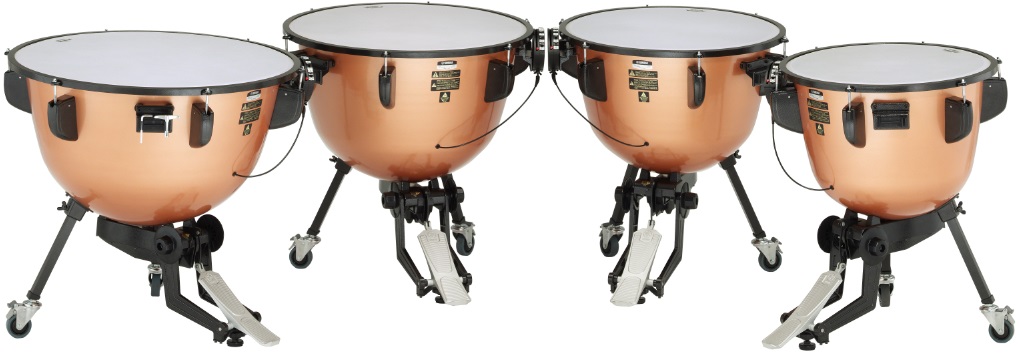
2016
7300R/ 6300R/4300R Series. Minor updates included the following:
– An auxiliary brake added to the pedal caster for greater safety and security. If the performer neglects to engage the main caster brakes, this auxiliary brake can be engaged to prevent movement.
– Easier main caster height adjustment with the use of a tuning key. This can be done by a single person without having to lift the caster off the floor.
– A revised wrench key holder. In previous models, the key/wrench holder was attached with adhesive tape, making it necessary to use new tape when changing the holder location. The new holder attaches with a bolt, allowing it to be changed easily and repeatedly as needed.
– An improved tuning indicator. The width of the accidental note name markers was increased by 1.5 mm to make positioning easier, and to make them less likely to drop inside the indicator. At the same time, the width of the natural note name markers was reduced by 1.0 mm to maintain comfortable marker spacing. An “H” marker is now supplied as a standard accessory, allowing the player to choose “B” or “H” according to preference.
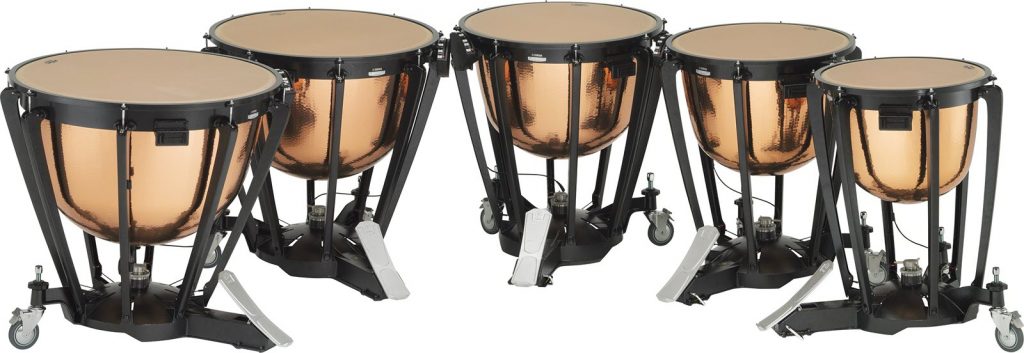

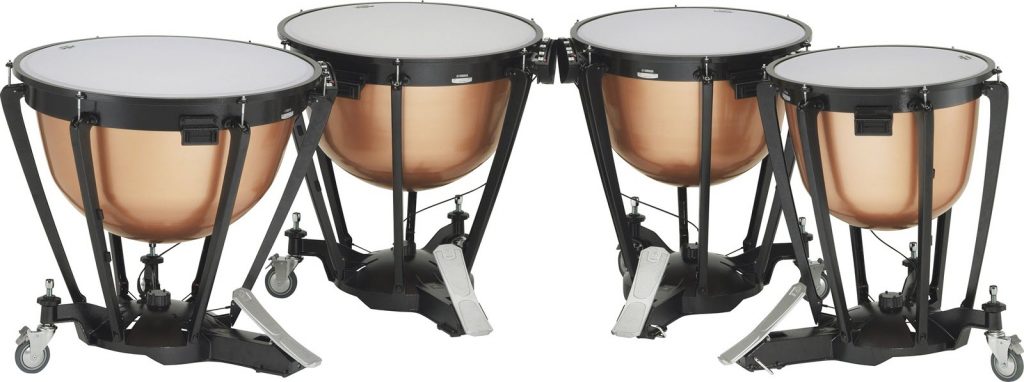
8300R Series. These top-of-the-line timpani include most of the features of the 7300 Series, with two exceptions: The use of cambered hammered copper bowls (for extra volume as well as optimum resonance and decay) and extra flexibility when adjusting the pedal balance spring system by using a knob located on top of the spider. (The latter is also a feature of 7300R Series timpani.) In addition, the 8300R Series offers optional 24″ and 27″ sizes for expanded musical potential.
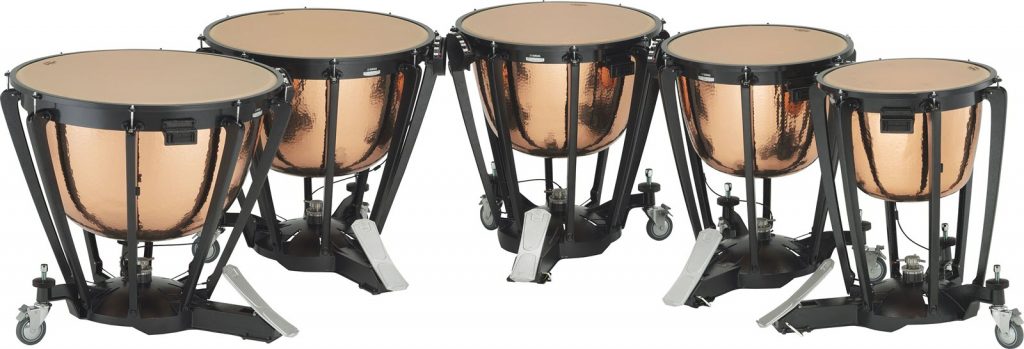
Click here for more information about Yamaha timpani.










